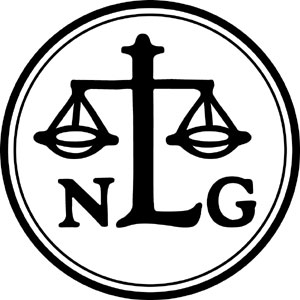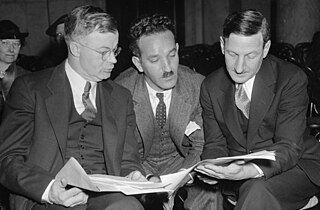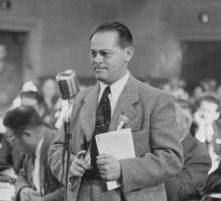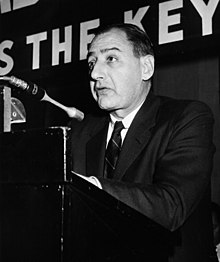
The National Lawyers Guild (NLG) is a progressive public interest association of lawyers, law students, paralegals, jailhouse lawyers, law collective members, and other activist legal workers, in the United States. The group was founded in 1937 as an alternative to the American Bar Association (ABA) in protest of that organization's exclusionary membership practices and conservative political orientation. They were the first predominantly white US bar association to allow the admission of minorities to their ranks. The group sought to bring more lawyers closer to the labor movement and progressive political activities, to support and encourage lawyers otherwise "isolated and discouraged," and to help create a "united front" against Fascism.

Lee Pressman was a labor attorney and earlier a US government functionary, publicly alleged in 1948 to have been a spy for Soviet intelligence during the mid-1930s, following his recent departure from Congress of Industrial Organizations (CIO) as a result of its purge of Communist Party members and fellow travelers. From 1936 to 1948, he represented the CIO and member unions in landmark collective bargaining deals with major corporations including General Motors and U.S. Steel. According to journalist Murray Kempton, anti-communists referred to him as "Comrade Big."
John Jacob Abt was an American lawyer and politician, who spent most of his career as chief counsel to the Communist Party USA (CPUSA) and was a member of the Communist Party and the Soviet spy network "Ware Group" as alleged by Whittaker Chambers.

Nathan Witt, born Nathan Wittowsky, was an American lawyer who is best known as being the Secretary of the National Labor Relations Board (NLRB) from 1937 to 1940. He resigned from the NLRB after his communist political beliefs were exposed, and he was accused of manipulating the Board's policies to favor his own political leanings. He was also investigated several times in the late 1940s and 1950s for being a spy for the Soviet Union in the 1930s. No evidence of espionage was ever found.
Marion Bachrach was a member of the Ware group, a group of government employees in the New Deal administration of President Franklin D. Roosevelt who were also members of the secret apparatus of the Communist Party of the United States (CPUSA) in the 1930s. She was the sister of John Abt.

The International Fur and Leather Workers Union (IFLWU), was a labor union that represented workers in the fur and leather trades.
The Ware Group was a covert organization of Communist Party USA operatives within the United States government in the 1930s, run first by Harold Ware (1889–1935) and then by Whittaker Chambers (1901–1961) after Ware's accidental death on August 13, 1935.

Benjamin Gold (1898–1985) was an American labor leader and Communist Party member who was president of the International Fur and Leather Workers Union (IFLWU) from 1937 to 1955.

Joseph Warren Madden was an American lawyer, judge, civil servant, and educator. He served as a judge of the United States Court of Claims and was the first Chairman of the National Labor Relations Board. He received the Medal of Freedom in 1947.
The International Juridical Association was an association of socially minded American lawyers, established by Carol Weiss King and considered by the U.S. federal government as "another early (communist) front for lawyers. The principal concern about the IJA was that it "constituted itself an agent of a foreign principal hostile to the interests of the United States."
Joseph Forer was a 20th-century American attorney who, with partner David Rein, supported Progressive causes, including discriminated communists and African-Americans. Forer was one of the founders of the National Lawyers Guild and its DC chapter. He was also an expert in the "Lost Laws" of Washington, DC, enacted in 1872–1873, that outlawed segregation at business places.
Allan Robert Rosenberg was a 20th-century American labor lawyer and civil servant, accused as a Soviet spy by Elizabeth Bentley and listed under Party name "Roy, code names "Roza" in the VENONA Papers and code name "Sid" in the Vasilliev Papers; he also defended Dr. Benjamin Spock.
The first-ever "political action committee" in the United States of America was the Congress of Industrial Organizations – Political Action Committee or CIO-PAC (1943–1955). What distinguished the CIO-PAC from previous political groups was its "open, public operation, soliciting support from non-CIO unionists and from the progressive public. ... Moreover, CIO political operatives would actively participate in intraparty platform, policy, and candidate selection processes, pressing the broad agenda of the industrial union movement."
Joseph Kovner was a 20th-century American lawyer and government official, best known as assistant general counsel to Lee Pressman for the Congress of Industrial Organizations (CIO) in the 1930s and 1940s and then attorney with the Justice Department.
Charles James Hendley (1881–1962) was an American teacher, education reformer, and union activist. He served as president of the New York City Teachers Union (TU) from 1935 to 1945.
Morris Iushewits or Iushewitz was a union activist and leader of the Newspaper Guild, the Congress of Industrial Organizations (CIO), and the American Federation of Labor and Congress of Industrial Organizations (AFL–CIO).
David Rein (1914–1979) was a 20th-Century American attorney who, with partner Joseph Forer, supported Progressive causes including the legal defense of African-Americans and accused Communists. Rein and Foyer were members of the National Lawyers Guild and its D.C. chapter. Rein represented "more than 100 people", alleged to have been Communists, before the House Un-American Activities Committee (HUAC) and the subcommittee of the Senate Committee on Administration.
Thomas I. Emerson (1907–1991) was a 20th-century American attorney and professor of law. He is known as a "major architect of civil liberties law," "arguably the foremost First Amendment scholar of his generation," and "pillar of the Bill of Rights."
George Andersen was an American lawyer and partner in the San Francisco-based law firm of Gladstein, Andersen, Leonard & Sibbett. One of his clients, Harry Bridges of the International Longshore and Warehouse Union (ILWU), allegedly supported communist or pro-communist legal organizations from the 1930s to the 1960s including International Labor Defense, the International Juridical Association, and the National Lawyers Guild as well as holding stock in the communist newspaper People's World.
Roy Hudson, also known as Roy B. Hudson, served on the national executive board of the Communist Party USA and national trade union director and trade union expert.








